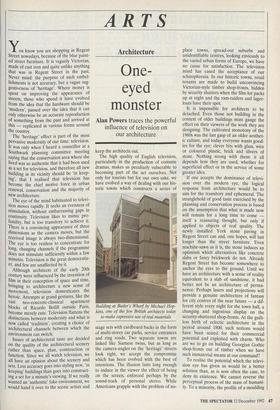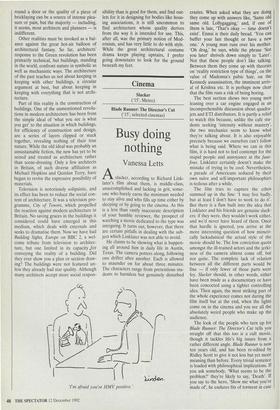ARTS
Architecture
One-
eyed monster
Alan Powers traces the powerful influence of television on our architecture
You know you are shopping in Regent Street nowadays, because of the blue paint- ed street furniture. It is vaguely Victorian, made of cast iron and quite unlike anything that was in Regent Street in the past. Never mind: the purpose of such embel- lishments is not accuracy, but a vague sug- gestiveness of 'heritage'. Where money is spent on improving the appearance of streets, those who spend it have evolved from the idea that the hardware should be `modern', passed over the idea that it can only otherwise be an accurate reproduction of something from the past and arrived at this — replicated in various forms around the country.
The 'heritage' effect is part of the most pervasive modernity of our time: television. It was only when I heard a councillor at a Southwark planning committee meeting saying that the conservation area where she lived was so authentic that it had been used as a set for television, and therefore all new building in its vicinity should be 'in keep- ing', that I realised that television has become the chief motive force in urban renewal, conservation and the majority of new architecture.
The eye of the mind habituated to televi- sion moves rapidly. It seeks an evenness of stimulation, without embarrassing gaps in continuity. Television likes to mimic pro- fundity, but is too transitory to achieve it. There is a convincing appearance of three dimensions as the camera moves, but the received image is always two-dimensional. The eye is too restless to concentrate for long, changing channels if the programme does not stimulate sufficiently within a few minutes. Television is the great democratis- er, and few are unaffected by it. Although architects of the early 20th century were influenced by the invention of film in their conception of space and time, bringing to architecture a new sense of movement, television domesticates the heroic. Attempts at grand gestures, like the vast neo-concrete-classical apartment blocks of Ricardo Bofill outside Paris, become merely cute. Television flattens the distinctions between modernity and what is now called 'tradition', creating a choice of architectural channels between which the environment can switch.
Issues of architectural taste are decided on the quality of the architectural scenery rather than space, plan, construction or function. Since we all watch television, we all have an opinion about the scenery and sets. Less accuracy goes into styling new, `in keeping' buildings than goes into construct- ing a set for a minute's viewing. If we really wanted an 'authentic' fake environment, we would hand it over to the scenic artists and keep the architects out.
The high quality of English television, particularly in the production of costume dramas, makes us peculiarly vulnerable to becoming part of the act ourselves. Not only for tourists but for our own sake, we have evolved a way of dealing with our his- toric towns which constructs a series of
Building at Butler's Wharf by Michael Hop- kins, one of the few British architects today to make expressive use of real materials
stage sets with cardboard backs in the form of multi-storey car parks, service entrances and ring roads. Two separate towns are linked like Siamese twins, but as long as the camera-angles on the 'heritage' streets look right, we accept the compromise which has been evolved with the best of intentions. The illusion lasts long enough to induce in the viewer the effect of being on the screen, enforced perhaps by the sound-track of personal stereo. While Americans grapple with the problem of no- place towns, spread-out suburbs and unidentifiable centres, looking enviously to the varied urban forms of Europe, we have no cause for satisfaction. The television mind has eased the acceptance of our schizophrenia. In our historic towns, retail tenants are made to build unconvincing Victorian-style timber shop-fronts, hidden by security shutters when the film-lot packs up at night and the ram-raiders and lager- louts have their spot.
It is impossible for architects to be detached. Even those not building in the context of older buildings must gauge the effect on their viewers of the work they are designing. The cultivated monotony of the 1960s was the last gasp of an older aesthet- ic culture, and today everyone wants good- ies for the eye: clever bits with glass, wire or coloured plastic, brick and slivers of stone. Nothing wrong with them: it all depends how they are used, whether for superficial effect or in the service of some greater idea.
If one accepts the dominance of televi- sion over the modern eye, the logical response from architecture would be to aim for the transitory and ephemeral. The stranglehold of good taste exercised by the planning and conservation process is based on the assumption that what is made now will remain for a long time to come itself a reassuring thought, but only if applied to objects of real quality. The newly installed York stone paving in Regent Street can and, one hopes, will last longer than the street furniture. Even machine-sawn as it is, the stone induces an optimism which alternatives like concrete slabs or fancy brickwork do not. Already Regent Street has become somewhere to anchor the eyes to the ground. Until we have an architecture with a sense of reality equivalent to a slab of sandstone, it had better not be an architecture of perma- nence. Perhaps lasers and projections will provide a genuine architecture of fantasy for city centres of the near future — a dif- ferent style every night for the town hall, a changing and ingenious display on the security-shuttered shop-fronts. At the guilt- less birth of eclectic architecture in the period around 1800, such notions would have been seized for their commercial potential and exploited with charm. Who are we to go on building Georgian Gothic shop-fronts out of timber when we have such immaterial means at our command?
To realise the potential which the televi- sion eye has given us would be a better solution than, as is now often the case, to deny its existence. We cannot reverse the perceptual process of the mass of humani- ty. To a minority, the profile of a moulding round a door or the quality of a piece of bricklaying can be a source of intense plea- sure or pain, but the majority — including, it seems, most architects and planners — is indifferent.
Other realities must be invoked as a bal- ance against the great hot-air balloon of architectural fantasy. So far, architects' response to the Green revolution has been primarily technical, but buildings, standing in the world, confront nature in symbolic as well as mechanistic ways. The architecture of the past teaches us not about keeping in keeping with other buildings, a circular argument at best, but about keeping in keeping with everything that is not archi- tecture.
Part of this reality is the construction of buildings. One of the unmentioned revolu- tions in modern architecture has been from the simple ideal of 'what you see is what you get' to the situation in which buildings, for efficiency of construction and design, are a series of layers clipped or stuck together, revealing nothing of their true nature. While the old ideal was probably an unsustainable fiction, the new has yet to be seized and treated as architecture rather than scene-dressing. Only a few architects in Britain, of such diverse affiliation as Michael Hopkins and Quinlan Terry, have begun to revive the expressive possibility of materials.
Television is notoriously solipsistic, and its effect has been to reduce the social con- tent of architecture. It was a television pro- gramme, City of Towers, which propelled the reaction against modern architecture in Britain. No saving graces in the buildings it considered could have emerged in this medium, which deals with externals and seeks to dramatise them. Now we have had Building Sights, Europe on BBC 2, a wel- come tribute from television to architec- ture, but one limited in its capacity for conveying the reality of a building. Did they ever show you a plan or section draw- ing? The buildings were not featured un- less they already had star quality. Although many architects accept more social respon-
sibility than is good for them, and find out- lets for it in designing for bodies like hous- ing associations, it is still uncommon to find architecture whose quality derives from the way it is intended for use. This, after all, was the primary notion of Mod- ernism, and has very little to do with style. While the great architectural costume drama keeps playing upstairs, I prefer going downstairs to look for the ground beneath my feet.



































































 Previous page
Previous page